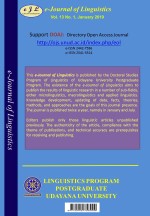Verbal Clause Construction of Ciacia Language: Syntactic Typology Study
Abstract
Typology study of Ciacia language (CL) in various linguistic aspects has not been conducted yet. It is the first study that focus on syntactic typology. Ciacia language is one of local languages in Buton Regency, Southeast Sulawesi Province. The study focuses on five main problems, they are (1) How is the base construction of verbal clause in CL? (2) How are the predicate and structure argument constructions of verbal clause in CL, (3) How are the simple predicate and complex predicate constructions of verbal clause in CL? (4) How are valency and valency change mechanism of verbal clause construction in CL? (5) How are complex sentence construction and grammatical alliance system?. The oral data of this study is obtained through recording and elicitation techniques. Written data is obtained through the previous studies. The study also used synthetic data which is verrified by the informants. The data was analyzed by apportion (distributional) method.
The investigation of clause base construction shows that verbal clause construction of Ciacia language is always filled by subject and aspect markers (PS/A) that is affixed to PRED verb. Base structure of verbal clause in CL consists of verbal predicated clause and non-verbal predicated clause. Non-verbal predicated clause can be constructed through base nominal and adjective categories. Verbal clause predicate can be filled by intransitive base verb, mono transitive base verb, ditransitive base verb, and ambi-transitive base verb.
Predication and argument structure of verbal clause construction in CL can be classified in to verbal clause: (i) intransitive with one main argument in terms of SUBJ and as A or OBJ systematically; (ii) semi-transitive with one main argument as A/ACT and with the presence of OBJ argument optionally; (iii) mono-transitive with two main arguments, namely SUBJ as A/ACT with one OBJ argument as UND, (iv) ditransitive with three main arguments, namely SUBJ as A/ACT before PRED and two arguments after PRED, in terms of OTL (indirect object) and OL (direct object); and (v) ambi-transitive with one main argument, namely SUBJ, either as Sa or as So.
Valency and transitivity of verbal clause construction in CL consists of (i) valency and intransitive verb transitivity with one argument or verb with one valency; (ii) semi-transitive verb with one argument before verb and the presence of argument after Pred verb optionally; (iii) transitive with the obligatory of O presence after Pred verb, so it has two main arguments or verb that has two valency arguments, namely S and O; (iv) ditransitive with three main arguments or verb that has three valency arguments; (v) ambi-transitive with only one argument or verb that has one valency.
Verbal clause construction in CL can be filled by simple Pred verb and complex Pred verb. Simple predicate is created by base verb/intransitive verb and non-verb category, semi-transitive verb, and transitive verb with PS/A. Complex predicate is created through verb (i) intransitive; (ii) semi-transitive verb; and (iii) transitive integral verb. The valency change mechanism of verbal clause construction in CL can be done through formal causativation and semantic causativation, applicative, and resultative.
Downloads
References
Artawa, Ketut and Jufrizal. 2018. Linguistik Tipologi. Denpasar:Universitas Udayana.
Artawa, Ketut. 2000. “Alternasi Diatesis pada Beberapa Bahasa Nusantara”:Dalam
Kajian Serba Linguistik untuk Anton M. Moeliono, ed. Bambang Kaswanti
Purwo). Jakarta:Universitas Katolik Atma Jaya dan PT BPK Gunung Mulia
Comrie, Bernad. 1983, 1989. Language Universals and Linguistic Typologys. Oxford:Basil Blackwell Publishid Limited.
Djajasudarma, T. Fatimah. 2010. Metode Linguistik Ancangan Metode Penelitian dan Kajian. Bandung:Refika Aditama.
Dixon, R.M.W. 1994. Ergativity. Camridge University Press.
Dixon, R.M.W. 2010. Basic Linguistic Theory Volume 1 Methodology. Oxford University Press.
Dixon, R.M.W. 2010. Basic Linguistic Theory Volume 2 Grammatical Topics.
Oxford University Press
Dixon, R.M.W. 2012. Basic Linguistic Theory Volume 3 Further Grammatical
Topics. Oxford University Press.
Mahsun. 2013. Metode Penelitian Bahasa. Tahapan Strategi, Mtode, dan Tekniknya (edisi revisi).Depok.Rajawali Press.
Mallinson, Graham and Barry J. Blake. 1981. Language Typology. Cross Linguistic Studies on Syntax. Amsterdam:Nort-Holand.
Mithun, Marrianne. 2001. “Who Shapes The Record:The Speaker and The Linguist”, In Newman, Paul and Martha Ratliff (ed). Linguistic Fiedlwork. Cambridge:Cambridge University Press.
Payne, Thomas. 2002. Describing Morphosyntax:A Giude for Field Linguistics. Cambridge:Cambridge University Press.
Song, Jae Jung (ed). 2001. Linguistic Typology:Morphology and Syntax. Harlow:Longman.
Sudaryanto. 1993, 2015. Metode dan Aneka Teknik Analisis Bahasa, Yokyakarta:Gajah Mada University Press.
Van Valin, Robert., Jr and Wiliam A Foley. 1980. “Role and Rference Grammar” dalam Moravesik and Wirth. Editos
Van Valin, Robert., Jr dan Randy J. La Polla. 1997. Syntax:Structure Meaning and Function. Cambridge:Cambridge University Press.

This work is licensed under a Creative Commons Attribution 4.0 International License.

This work is licensed under a Creative Commons Attribution 4.0 International License











